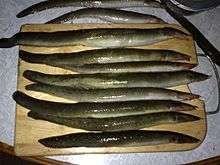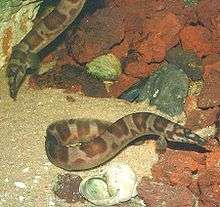Mastacembelus
| Mastacembelus | |
|---|---|
 | |
| Mastacembelus moorii | |
| Scientific classification | |
| Kingdom: | Animalia |
| Phylum: | Chordata |
| Class: | Actinopterygii |
| Order: | Synbranchiformes |
| Family: | Mastacembelidae |
| Genus: | Mastacembelus Scopoli, 1777 |
| Type species | |
| Ophidium mastacembelus J. Banks & Solander, 1794 | |
| Species | |
|
See text | |
| Synonyms | |
Mastacembelus is a genus of many species of spiny eel fish from the family Mastacembelidae. They are native to Africa (c. 45 species) and Asia (c. 15 species).[3] Most are found in rivers and associated systems (even in rapids[4]), but there are also species in other freshwater habitats and a particularly rich radiation is found in the Lake Tanganyika basin with 15 species (14 endemic).[5][6] A few species can even occur in brackish water.[7]
Appearance

The size and pattern varies greatly depending on the exact species of Mastacembelus. The smallest are M. latens and M. simba, which only reach a maximum total length of 7–8 cm (2.8–3.1 in).[3][4] At up to 1 m (3.3 ft), the largest of both the family and this genus is M. erythrotaenia.[3][8] M. erythrotaenia, often known as the fire eel, is blackish with an orange-red pattern, and it is a popular aquarium fish.[8] Otherwise species in this genus are typically brownish and often have a spotted, speckled or mottled pattern, either in another brown hue, grayish or yellowish. This pattern is reflected in the common name of another species sometimes kept in aquariums, the zig-zag eel M. armatus (alternatively called the tire track eel, a name otherwise used for M. favus). A few others also occasionally appear in the aquarium trade,[8] and some are considered good food fish and eaten locally.[7] M aviceps, M. brichardi, M. crassus and M. latens are found in dark, deep parts of the Congo River and sometimes shallower among rocks. These four species have reduced eyes and are all pinkish-white in color (non-pigmented), similar to cavefish.[4]
Taxonomy
In an evaluation of the Mastacembelidae in 2005, the genera Caecomastacembelus and Aethiomastacembelus (formerly used for the African species) were placed in synonymy with Mastacembelus.[1]
Species




According to FishBase, there are currently 61 recognized species in this genus.[3] 4 additional species (marked with a star* in the list) are recognized by Catalog of Fishes.[10]
- Mastacembelus alboguttatus Boulenger, 1893
- Mastacembelus albomaculatus Poll, 1953
- Mastacembelus ansorgii Boulenger, 1905
- Mastacembelus apectoralis K. J. Brown, Britz, I. R. Bills, Rüber & J. J. Day, 2011
- Mastacembelus armatus (Lacépède, 1800) (Zig zag eel)
- Mastacembelus aviceps T. R. Roberts & D. J. Stewart, 1976
- Mastacembelus batesii* Boulenger, 1911
- Mastacembelus brachyrhinus Boulenger, 1899
- Mastacembelus brichardi Poll, (1958) (Blind spiny eel)
- Mastacembelus catchpolei Fowler, 1936
- Mastacembelus congicus Boulenger, 1896
- Mastacembelus crassus T. R. Roberts & D. J. Stewart, 1976
- Mastacembelus cryptacanthus Günther, 1867
- Mastacembelus cunningtoni Boulenger, 1906
- Mastacembelus dayi Boulenger, 1912 – junior synonym of M. alboguttatus according to Catalog of Fishes[10]
- Mastacembelus decorsei Pellegrin, 1919
- Mastacembelus dienbienensis V. H. Nguyễn & H. D. Nguyễn, 2005 – belongs in genus Sinobdella according to Catalog of Fishes[10]
- Mastacembelus ellipsifer Boulenger, 1899
- Mastacembelus erythrotaenia Bleeker, 1850 (Fire eel)
- Mastacembelus favus Hora, 1924 (Tire track eel)
- Mastacembelus flavidus Matthes, 1962
- Mastacembelus flavomarginatus* Boulenger, 1898
- Mastacembelus frenatus Boulenger, 1901 (Longtail spiny eel)
- Mastacembelus goro* Boulenger, 1902
- Mastacembelus greshoffi Boulenger, 1901
- Mastacembelus kakrimensis Vreven & Teugels, 2005
- Mastacembelus latens T. R. Roberts & D. J. Stewart, 1976
- Mastacembelus liberiensis Boulenger, 1898
- Mastacembelus loennbergii Boulenger, 1898
- Mastacembelus malabaricus* Jerdon, 1849
- Mastacembelus marchei Sauvage, 1879
- Mastacembelus mastacembelus (J. Banks & Solander, 1794)
- Mastacembelus micropectus Matthes, 1962
- Mastacembelus moorii Boulenger, 1898
- Mastacembelus niger Sauvage, 1879
- Mastacembelus nigromarginatus Boulenger, 1898
- Mastacembelus notophthalmus T. R. Roberts, 1989
- Mastacembelus oatesii Boulenger, 1893
- Mastacembelus ophidium Günther, 1894
- Mastacembelus pantherinus Britz, 2007
- Mastacembelus paucispinis Boulenger, 1899
- Mastacembelus plagiostomus Matthes, 1962
- Mastacembelus platysoma Poll & Matthes, 1962
- Mastacembelus polli Vreven, 2005
- Mastacembelus praensis (Travers, 1992)
- Mastacembelus reygeli Vreven & Snoeks, 2009
- Mastacembelus robertsi (Vreven & Teugels, 1996)
- Mastacembelus sanagali Thys van den Audenaerde, 1972
- Mastacembelus seiteri Thys van den Audenaerde, 1972
- Mastacembelus sexdecimspinus (T. R. Roberts & Travers, 1986)
- Mastacembelus shiloangoensis (Vreven, 2004)
- Mastacembelus shiranus Günther, 1896 (Malawi spiny eel)
- Mastacembelus simbi Vreven & Stiassny, 2009
- Mastacembelus strigiventus W. Zhou & L. P. Yang, 2011
- Mastacembelus taiaensis (Travers, 1992)
- Mastacembelus tanganicae Günther, 1894
- Mastacembelus thacbaensis V. H. Nguyễn & H. D. Nguyễn, 2005 – junior synonym of M. undulatus according to Catalog of Fishes[10]
- Mastacembelus tinwini Britz, 2007
- Mastacembelus traversi (Vreven & Teugels, 1997)
- Mastacembelus triolobus W. Zhou & L. P. Yang, 2011
- Mastacembelus trispinosus Steindachner, 1911
- Mastacembelus undulatus (McClelland, 1844)
- Mastacembelus unicolor G. Cuvier, 1832
- Mastacembelus vanderwaali P. H. Skelton, 1976 (Ocellated spiny eel)
- Mastacembelus zebratus Matthes, 1962
References
- 1 2 3 Vreven, E. J. (2005). "Mastacembelidae (Teleostei; Synbranchiformes) subfamily division and African generic division: an evaluation". Journal of Natural History. 39 (4): 351–370. doi:10.1080/0022293042000195975.
- ↑ http://research.calacademy.org/redirect?url=http://researcharchive.calacademy.org/research/ichthyology/catalog/fishcatget.asp&genid=7163 Archived 2012-04-02 at the Wayback Machine.
- 1 2 3 4 Froese, Rainer, and Daniel Pauly, eds. (2018). Species of Mastacembelus in FishBase. April 2018 version.
- 1 2 3 Elizabeth Alter, S.; Brown, B.; Stiassny, M.L.J. (2015). "Molecular phylogenetics reveals convergent evolution in lower Congo River spiny eels". BMC Evolutionary Biology. 15 (1). doi:10.1186/s12862-015-0507-x.
- 1 2 3 Brown; Rüber; Bills; Day (2010). "Mastacembelid eels support Lake Tanganyika as an evolutionary hotspot of diversification". BMC Evolutionary Biology. 10: 188. doi:10.1186/1471-2148-10-188.
- 1 2 3 Brown; Britz; Bills; Rüber; Day (2011). "Pectoral fin loss in the Mastacembelidae: a new species from Lake Tanganyika". Journal of Zoology. 284 (4): 286–293. doi:10.1111/j.1469-7998.2011.00804.x.
- 1 2 3 4 Rayamajhi, A.; Jha, B.R.; Sharma, C.M. (2012). "Mastacembelus armatus". The IUCN Red List of Threatened Species. IUCN. 2010: e.T166586A6241626. doi:10.2305/IUCN.UK.2010-4.RLTS.T166586A6241626.en. Retrieved 14 May 2018.
- 1 2 3 "Mastacembelus erythrotaenia (Fire Eel)". Seriously Fish. Retrieved 14 May 2018.
- ↑ Schliewen, U. (1992). Aquarium Fish. Barron's Educational Series. ISBN 978-0812013504.
- 1 2 3 4 Eschmeyer, W.N.; R. Fricke; R. van der Laan (14 May 2018). "Catalog of Fishes". California Academy of Sciences. Retrieved 14 May 2018.
| Wikimedia Commons has media related to Mastacembelus. |